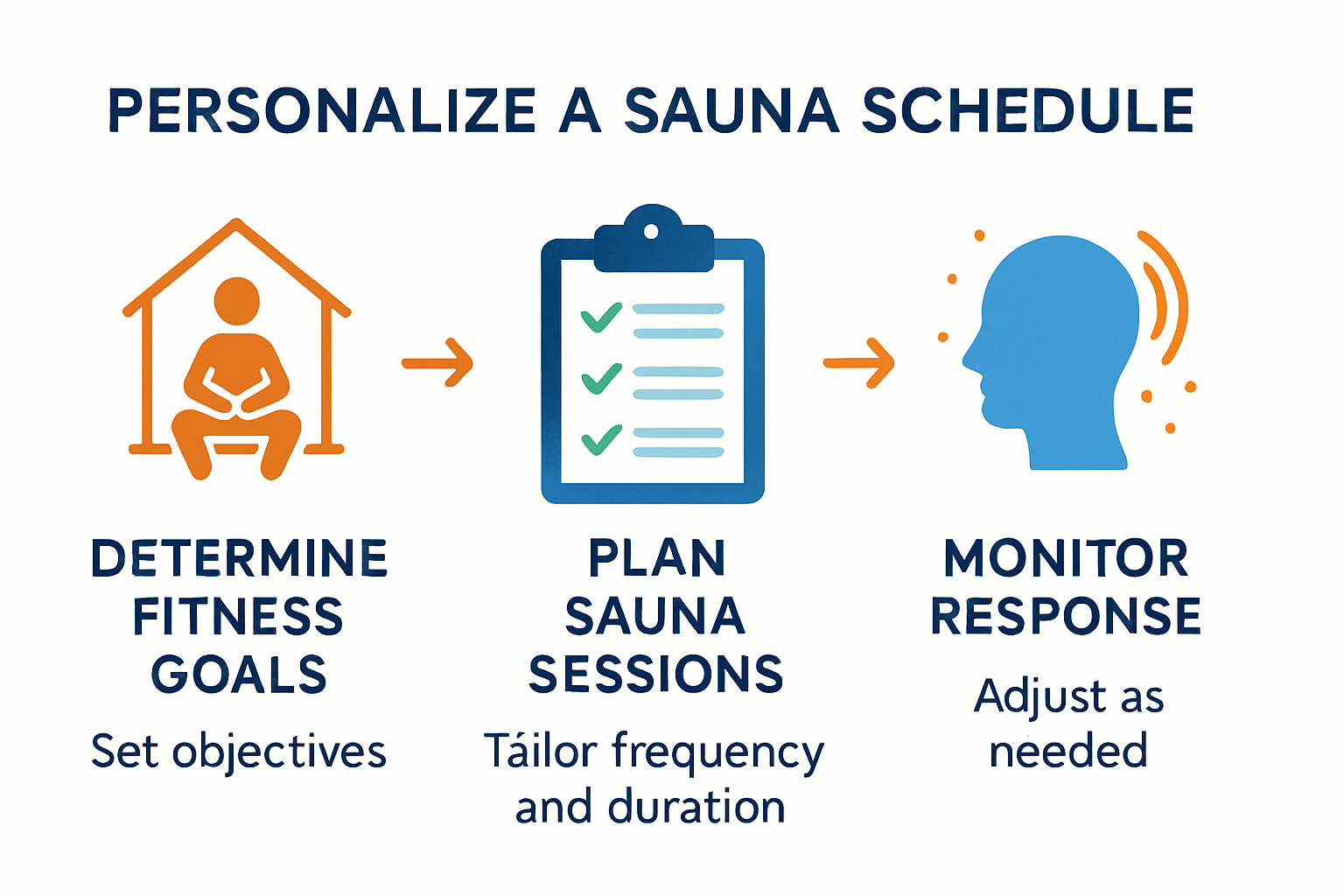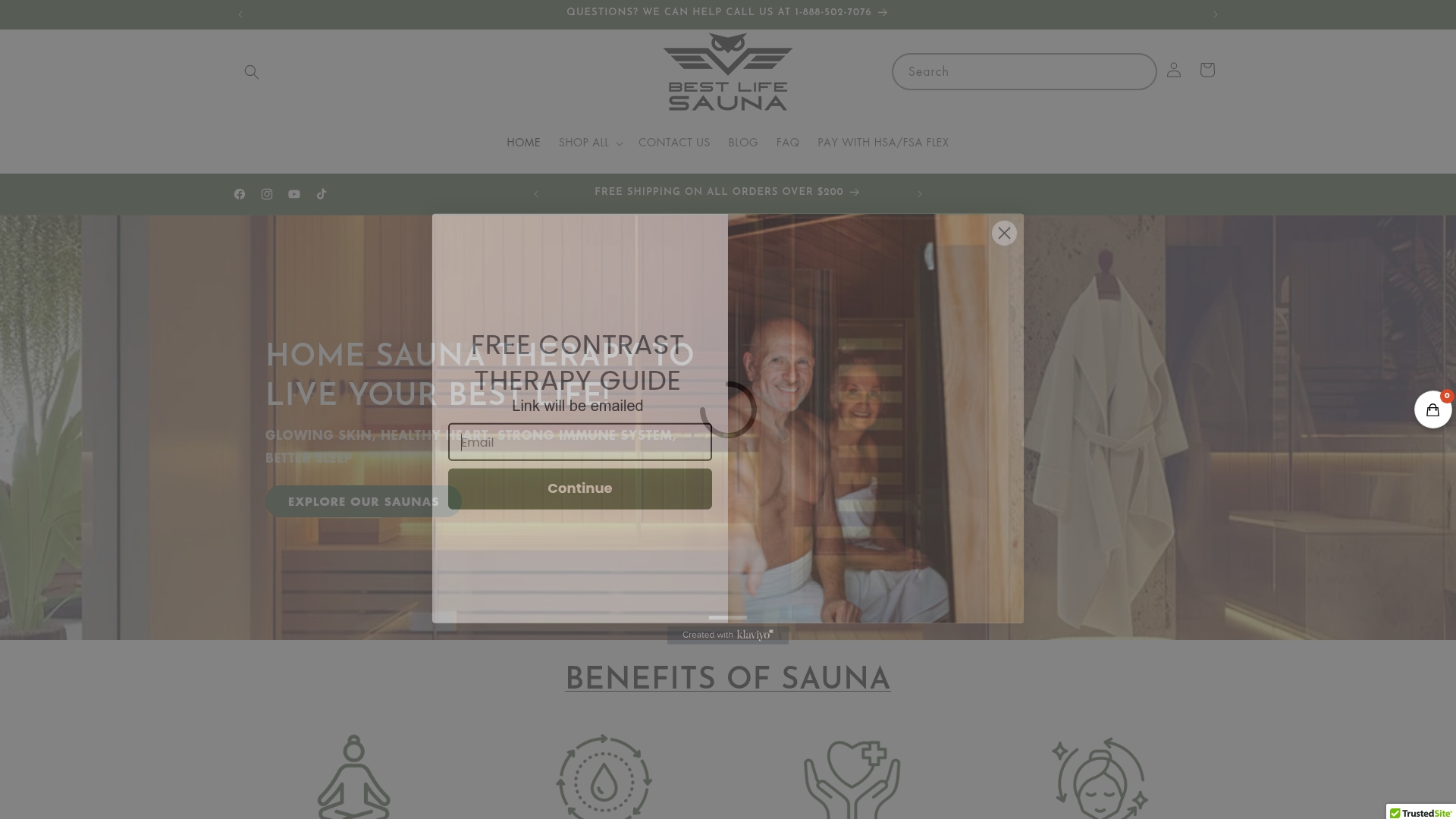
How to Incorporate Sauna Into Routine 2025
 Sauna use is gaining traction as a powerful aspect of modern wellness routines. Research shows that regular sauna sessions can lower your risk of heart disease by up to 63 percent. But here’s the kicker: many people still think of sauna time as just a luxury or a way to unwind. The reality is that incorporating sauna sessions strategically can enhance your physical recovery and mental clarity. This simple practice can change your approach to overall health in extraordinary ways.
Sauna use is gaining traction as a powerful aspect of modern wellness routines. Research shows that regular sauna sessions can lower your risk of heart disease by up to 63 percent. But here’s the kicker: many people still think of sauna time as just a luxury or a way to unwind. The reality is that incorporating sauna sessions strategically can enhance your physical recovery and mental clarity. This simple practice can change your approach to overall health in extraordinary ways.
Table of Contents
- Benefits Of Incorporating Sauna Time
- Best Time Sauna Before Or After
- Develop Your Ideal Sauna Schedule
- Safety Tips For Sauna Use
Quick Summary
| Takeaway | Explanation |
|---|---|
| Regular sauna use enhances cardiovascular health | Sauna sessions mimic moderate exercise, improving blood vessel elasticity and potentially lowering blood pressure, thereby reducing risks of cardiovascular diseases. |
| Sauna benefits mental health by reducing stress | Regular sauna users report increased happiness, lower anxiety and depression levels, and a therapeutic environment for mental restoration through heat-induced relaxation. |
| Post-exercise sauna sessions boost recovery | Utilizing a sauna after workouts can significantly reduce muscle soreness and inflammation, enhancing overall recovery and performance through improved blood circulation. |
| Optimal sauna frequency is 3-4 times per week | For best effects, aim for consistent sessions of 15-20 minutes, allowing recovery time between visits to maximize health benefits. |
| Stay hydrated and listen to your body | Drink at least 16 ounces of water for every 15 minutes in the sauna and monitor for any discomfort, adjusting session duration as needed to ensure safety. |
Benefits of incorporating sauna time
Incorporating sauna time into your wellness routine offers a comprehensive approach to physical and mental health that extends far beyond simple relaxation. Understanding the multifaceted advantages of regular sauna use can transform how you approach personal recovery and overall well-being.
Cardiovascular and Physiological Advantages
Regular sauna sessions provide remarkable cardiovascular benefits that mimic moderate exercise. Research indicates that sauna bathing produces physiological effects similar to physical activity, causing blood vessels to dilate and constrict - a process that acts as a form of “vascular exercise.” This unique mechanism helps improve blood vessel elasticity and potentially supports healthy blood pressure regulation.
The cardiovascular advantages are substantial. Studies from prominent health research centers have demonstrated that consistent sauna use is associated with reduced risks of cardiovascular diseases, respiratory conditions, and offers significant pain relief potential.
Mental Health and Stress Reduction
Beyond physical benefits, sauna incorporation provides profound mental health advantages. Psychological research reveals that individuals who regularly use saunas report higher energy levels, increased happiness, and notably lower levels of anxiety and depression. The heat-induced relaxation triggers the release of endorphins, your body’s natural mood elevators, creating a therapeutic environment for mental restoration.
The controlled, heated environment allows your mind to disconnect from daily stressors, promoting a meditative state that can significantly reduce mental tension. By dedicating time to sauna sessions, you’re not just treating your body but also providing crucial mental recovery and emotional reset.
Recovery and Performance Enhancement
Athletes and fitness enthusiasts are increasingly recognizing saunas as powerful recovery tools. The intense heat helps muscles relax, reduces inflammation, and accelerates post-exercise recovery. Increased blood circulation stimulated by sauna sessions can help remove metabolic waste products more efficiently, potentially reducing muscle soreness and supporting faster healing.
Integrating sauna time into your routine isn’t just a luxury - it’s a strategic approach to holistic wellness. By understanding and leveraging these comprehensive benefits, you transform a simple heat therapy session into a powerful tool for physical regeneration and mental equilibrium. Whether you’re seeking stress relief, cardiovascular support, or enhanced recovery, regular sauna incorporation offers a scientifically-backed pathway to improved overall health.
Best time sauna before or after
Determining the optimal timing for sauna sessions relative to your workout requires understanding the unique physiological impacts and potential benefits of pre- and post-exercise heat exposure. The strategic placement of sauna time can significantly influence your recovery, performance, and overall fitness outcomes.
Sauna After Exercise: The Recovery Powerhouse
Research indicates that post-exercise sauna bathing offers profound performance and recovery advantages. A compelling study demonstrated that consistently using sauna after workouts for three weeks enhanced endurance running performance, primarily by increasing blood volume. This suggests that timing your sauna session after exercise can be a strategic approach to athletic improvement.
The post-workout sauna protocol matters significantly. Studies recommend adding 15-minute sauna exposure three times weekly for eight weeks to maximize benefits. The heat exposure after exercise provides remarkable recovery benefits, with scientific evidence showing that sauna use can reduce muscle soreness by up to 47% within 24 hours, dramatically accelerating muscle recovery and reducing post-exercise inflammation.
Pre-Workout Sauna: Warming Up and Preparing the Body
Utilizing a sauna before exercise can serve as an advanced warm-up technique. The controlled heat environment helps increase core body temperature, enhance muscle flexibility, and potentially improve joint mobility. By gradually raising your internal temperature, you’re essentially priming your muscular and cardiovascular systems for upcoming physical exertion.
However, pre-workout sauna sessions require careful management. The heat can cause mild dehydration and potentially reduce exercise performance if not approached strategically. Experts recommend limiting pre-workout sauna time to 10-15 minutes and ensuring thorough hydration before, during, and after the session to mitigate potential negative impacts.
Personalized Timing Strategies
Ultimately, the ideal sauna timing depends on individual fitness goals, workout intensity, and personal physiological responses. Some athletes prefer post-workout sauna for recovery, while others find pre-workout heat exposure beneficial for muscle preparation. The key is experimenting and monitoring your body’s unique response.
Consider factors like workout type, intensity, personal recovery needs, and overall fitness objectives when determining your optimal sauna timing. For strength training, post-workout sauna might enhance muscle recovery. For endurance athletes, both pre- and post-workout sessions could offer complementary benefits.
Regardless of timing, maintaining proper hydration, listening to your body, and gradually integrating sauna sessions into your routine will help you maximize the potential health and performance benefits. The goal is creating a personalized approach that supports your individual wellness and fitness journey.
Develop your ideal sauna schedule
Creating a personalized sauna schedule requires thoughtful planning and understanding of your individual health goals, fitness level, and physiological responses. An effective sauna routine is not a one-size-fits-all approach but a tailored strategy that evolves with your wellness journey.
Frequency and Duration Guidelines
Research recommendations suggest an optimal sauna frequency of 3-4 sessions per week, with each session lasting 15-20 minutes. The key is consistency and allowing adequate recovery time between sessions - spacing them at least 24 hours apart ensures your body can effectively process and benefit from the heat exposure.
A landmark Finnish longitudinal study tracking 2,300 men over two decades revealed remarkable health benefits. Participants who used saunas 4-7 times weekly experienced a staggering 63% lower risk of sudden cardiac death compared to those using saunas only once weekly. The average session duration was around 14 minutes, highlighting that moderate, consistent exposure can yield significant health advantages.
Performance and Recovery Optimization
For athletes and fitness enthusiasts, sauna scheduling becomes a strategic performance enhancement tool. Performance research demonstrates that structured sauna protocols can yield impressive physiological adaptations. In one study focusing on runners, post-exercise sauna sessions (4 times per week at 87°C for approximately 30 minutes) resulted in:
- 32% increase in time to exhaustion
- 7.1% plasma volume expansion
- 5.6% total blood volume increase
These metrics underscore the potential of a methodical sauna approach in enhancing cardiovascular performance and recovery capacity.
Personalization and Progressive Adaptation
 Developing your ideal sauna schedule requires a personalized, progressive approach. Start with shorter, less frequent sessions and gradually increase intensity and duration. Monitor your body’s response, paying attention to hydration levels, recovery speed, and overall energy. Some individuals might thrive with daily short sessions, while others benefit more from longer, less frequent experiences.
Developing your ideal sauna schedule requires a personalized, progressive approach. Start with shorter, less frequent sessions and gradually increase intensity and duration. Monitor your body’s response, paying attention to hydration levels, recovery speed, and overall energy. Some individuals might thrive with daily short sessions, while others benefit more from longer, less frequent experiences.
Consider integrating sauna sessions around your workout routine, using them strategically for warm-up, cool-down, or dedicated recovery days. Individuals with different fitness goals - whether endurance training, strength development, or general wellness - will require nuanced scheduling approaches.
Listening to your body remains paramount. Some warning signs that indicate you might need to adjust your sauna schedule include persistent fatigue, decreased workout performance, prolonged muscle soreness, or feelings of dehydration. Consulting with healthcare professionals or fitness experts can provide personalized guidance tailored to your specific health profile and goals.
Remember, an ideal sauna schedule is dynamic. It should adapt to your changing fitness levels, lifestyle demands, and personal wellness objectives. Approach your sauna routine with curiosity, patience, and a commitment to understanding your body’s unique responses.
Safety tips for sauna use
Sauna use offers tremendous health benefits, but approaching these heat therapy sessions with proper safety precautions is crucial to ensuring a positive and risk-free experience. Understanding and implementing key safety protocols can transform your sauna time from a potential health risk to a genuinely therapeutic wellness practice.
Hydration and Preparation
Experts consistently emphasize the critical importance of hydration during sauna sessions. The recommended guideline is drinking at least 16 ounces of water for every 15 minutes spent in the sauna. This proactive approach prevents dehydration, which can lead to serious complications like heat exhaustion or heat stroke.
Preparing your body before entering the sauna involves more than just hydration. Remove any restrictive clothing, jewelry, or accessories that might trap heat. Consider bringing a towel to sit on and another to wipe away perspiration. For first-time users, medical professionals recommend starting with shorter 5-10 minute sessions and gradually increasing duration as your body adapts to the heat environment.
Medical Considerations And Precautions
Healthcare providers advise that individuals with specific health conditions should exercise extreme caution or avoid sauna use altogether. Those with uncontrolled high blood pressure, diabetes, heart failure, or other chronic health conditions must consult their healthcare provider before incorporating sauna sessions into their wellness routine.
Specifically critical safety recommendations include:
- Avoid alcohol consumption before or during sauna sessions
- Stop immediately if experiencing dizziness, lightheadedness, or extreme discomfort
- Limit individual sessions to 20 minutes maximum
- Exit the sauna if you feel overheated or unwell
Personal Monitoring And Comfort
Personal awareness is your most important safety tool during sauna use. Listen to your body’s signals and be prepared to exit the sauna if you feel uncomfortable. While some mild sweating and increased body temperature are expected, any signs of extreme fatigue, rapid heartbeat, or significant disorientation warrant immediate session termination.
For individuals with pre-existing health conditions or those taking medications that affect temperature regulation, additional precautions are necessary. Certain medications can impact your body’s ability to cool itself, potentially increasing risks during heat exposure. Always consult with a healthcare professional to understand how your specific health profile might interact with sauna use.
Start slowly and progressively. Your first few sauna experiences should be brief, allowing your body to acclimate to the heat environment. Pay attention to how you feel during and after sessions, adjusting duration and frequency based on your individual tolerance and comfort level.
Remember, sauna safety is about creating a balanced, mindful approach to heat therapy. By prioritizing hydration, understanding your personal health limitations, and maintaining constant bodily awareness, you can transform sauna sessions into a safe, rejuvenating component of your wellness routine.
Frequently Asked Questions
What are the benefits of incorporating sauna into my routine?
Incorporating sauna sessions can enhance cardiovascular health, improve mental well-being by reducing stress, and boost recovery after exercise. Regular sauna use is linked to lower risks of heart disease and greater overall happiness.
Should I use the sauna before or after my workout?
Using the sauna after a workout can significantly aid recovery by reducing muscle soreness and inflammation. However, a pre-workout sauna session can serve as an effective warm-up, increasing flexibility and preparing your body for exercise.
How often should I use the sauna for optimal benefits?
For best results, aim for 3-4 sauna sessions per week, with each session lasting 15-20 minutes. This frequency helps maximize health benefits while allowing adequate recovery time.
What safety precautions should I take when using a sauna?
Stay hydrated by drinking at least 16 ounces of water for every 15 minutes in the sauna. Consult a healthcare provider if you have existing health conditions, and limit your sessions to a maximum of 20 minutes, exiting if you feel overheated or unwell.
Elevate Your Wellness Journey with Best Life Sauna
Ready to transform your health and wellness routine by incorporating sauna sessions? As discussed in our article, using a sauna can significantly enhance your cardiovascular health, reduce stress, and accelerate muscle recovery. However, accessing a premium sauna that fits your lifestyle is crucial to reaping these transformative benefits.

At Best Life Sauna, we carry a variety of top-notch sauna options, including infrared, traditional, and even outdoor models, tailored to meet your unique needs. Imagine unwinding in the soothing heat of your very own sauna, elevating your overall well-being in the process. Don’t wait to experience the profound benefits of regular sauna use—our price match guarantee and glowing customer reviews ensure satisfaction every step of the way.
Why not start your journey to better health today? Explore our wide selection of premium saunas and accessories at Best Life Sauna. With free shipping on orders over $200, creating your dream wellness space has never been easier. Dive into relaxation and recovery—your body will thank you!
Recommended Articles
- 2025 Sauna Innovations in Wellness: Future Trends & Benefits – Best Life Sauna
- Effective Relaxation Techniques in Sauna for Stress Relief – Best Life SaunaBest Life Sauna - Premium Saunas for WellnessAmerican ExpressApple PayDiners ClubDiscoverGoogle PayMastercardPayPalShop PayVisa
- 2025 Aesthetic Sauna Designs: Stunning Ideas & Trends – Best Life Sauna
- Thermal Contrast Therapy for Your Best Life! – Best Life SaunaBest Life Sauna - Premium Saunas for WellnessAmerican ExpressApple PayDiners ClubDiscoverGoogle PayMastercardPayPalShop PayVisa
- News – Best Life SaunaBest Life Sauna - Premium Saunas for WellnessAmerican ExpressApple PayDiners ClubDiscoverGoogle PayMastercardPayPalShop PayVisa

